Final Fantasy XIII
The future belongs not to those who wait...
- —Final Fantasy XIII Game Trailer
The Battle Within Begins...
- —Final Fantasy XIII tagline
The game was released in Japan on December 17, 2009, and March 9, 2010 for North America and Europe. A traditional Chinese version for PlayStation 3 was released in May 27, 2010 [3]. Final Fantasy XIII is the first Final Fantasy game translated into traditional Chinese. A sequel titled Final Fantasy XIII-2 was released on December 15th, 2011, and a second sequel, Lightning Returns: Final Fantasy XIII, was announced on September 1st, 2012, and released in 2014.
Gameplay
Enemies will appear on the map and battles initiate when coming into contact with them. Treasure chests cannot be opened in close proximity to a monster, and there are several instances enemies are "guarding" treasures and must be banished to collect the loot. Shrouds can be used to move about the field without triggering enemy encounters, and to bestow the party with buffs prior to the battle's start.
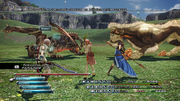
Three way battle between Behemoth King, Megistotherian, and the party.
Players can't set the party or the party leader until later into the game, diversity being brought in via the Paradigm Shift system. If the party leader is incapacitated in battle, it will result in a Game Over, but if a battle ends in defeat, the player will simply appear in the point on the field right before the fight was initiated, and they may either re-attempt the battle or leave it.
Final Fantasy XIII is the third main series Final Fantasy game in which the player does not routinely win gil from battles; rather the player obtains the currency from treasure spheres, or from selling items. The first such game was Final Fantasy VIII, where gil was received as SeeD salary, and the second was Final Fantasy XII, where although it is possible for some defeated enemies to drop gil, it is not a universal reward for victory.
Save Stations allow the player not only to save, but access the shops in Retail Network where items can be bought or sold.
Command Synergy Battle Edit
Edit
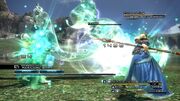
Combat in Final Fantasy XIII, showing Fang attacking an enemy.
- Main article: Command Synergy Battle
The Active Time Battle gauge is divided into sections. Each command has a numeric value referred to as "ATB Cost" next to the name indicating how many of these sections it will take up. This allows the player to input several commands per turn. The next turn comes up sooner if the ATB bar is only partially used. Magic and summoning are only available to party members who are l'Cie.
A new element called the Chain Gauge is specific to each enemy, and fills as the player performs attack combos marked by a percentage. Upon filling the gauge the enemy enters "Stagger Mode", where even more damage can be done. Staggered enemies can be launched in the air and juggled with attacks. Staggering is almost essential to winning many battles.
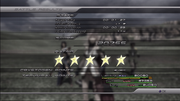
A Battle Result in Final Fantasy XIII.
When a battle is won, a Battle Results screen pops up, giving the player a zero-to-five stars ranking on how they did, as well as showing how long the battle took. This information is linked to the Trophy and Achievement systems.
Paradigm Shift Edit
Edit
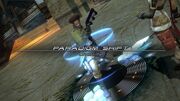
The Paradigm Shift system.
- Main article: Paradigm
The paradigms can be changed at any time to suit the situation at hand, but they cannot be changed individually, only for the whole party at a time. Thus, a paradigm is a combination of three roles. There are a total of 83 possible paradigm combinations (6 single, 21 double, and 56 triple member combinations). The roles used are shown as colored abbreviations next to the characters' names in the battle screen.
The roles within the paradigms are:
| Role | Color | Description |
|---|---|---|
| Commando (COM) (Attacker (ATK)) | Build attack chains more easily with enhanced strength. | |
| Ravager (RAV) (Blaster (BLA)) | Charge enemy chain gauges with concentrated attacks. | |
| Sentinel (SEN) (Defender (DEF)) | Shield allies from enemy attacks. | |
| Saboteur (SAB) (Jammer (JAM)) | Enfeeble enemies while charging their chain gauges. | |
| Synergist (SYN) (Enhancer (ENH)) | Support allies with an array of magical enhancements. | |
| Medic (MED) (Healer (HLR)) | Focus on restoring HP and removing status ailments. |
Crystarium Edit
Edit
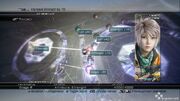
Hope's Crystarium.
- Main article: Crystarium System
The available abilities in the Crystaria vary between party members, but series staples such as Attack, Fire, Blizzard, and Cure make a return, along with new commands such as Blitz, which causes area-of-effect damage, and Ruin, a new non-elemental spell.
The system opens up in stages, and party members cannot develop further after reaching the end of the current stage. The final stage of the Crystarium is only opened by defeating the final boss, meaning to fully develop the party players must take on the post-game content.
Equipment Edit
Edit
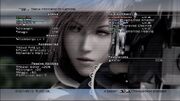
Lightning's status screen.
All characters can equip all accessories. Each character can initially equip one accessory at a time, but this capacity can be increased to up to four through upgrades obtained in the characters' Crystaria.
In addition to the basic enhancements provided by weapons and accessories, when a character equips weapons and accessories that belong to the same "synthesis" group (a hidden property), the character can gain additional passive enhancements (such as increased ATB gauge recharge rate).
The basic enhancements weapons and accessories grant to characters can also increase as the items are upgraded through the application of various components to increase its Experience Points (EXP). When the weapon or accessory reaches a certain number of EXP, it will be upgraded to a new "level". Once it reaches a certain level (usually 25 for weapons and 2 to 5 for equipment), the number will be replaced by a star (★), at which point it can no longer be upgraded by standard components. It can however be transformed with a stone ore catalyst into a new stage of the same class of equipment, with a new name, that can then continue to be levelled up for higher bonuses, although there are some accessories that transform into an item of a completely different synthesis group.
There are three types of components: biological, mechanical and monetary. Biological components are dropped by biological enemies and although they don't generally have a high EXP value, they do increase the EXP bonus of the weapon or accessory, meaning that subsequent components will give up to 300% more EXP points compared to their base value. Mechanical components are dropped by mechanical enemies, and work in the opposite way to biological components, giving a high number of EXP points, at the expense of reducing the EXP bonus. Therefore, biological components should be used to build up the EXP bonus, before using mechanical components to add EXP. The final type is monetary components. These are dropped by human enemies, and although they have a nominal EXP value, they are intended to be sold for gil at shops to buy other, more effective components.
Summoning Edit
Edit
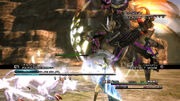
Bahamut summoned to battle.
- Main article: Eidolon (Final Fantasy XIII)
The playable Eidolons have mechanical designs and the power to transform. The Eidolons are used both as a gameplay feature and as plot devices. Each character has one Eidolon, and Eidolons replace the other party members besides the summoner when called.
Eidolons are summoned by the use of Technical Points (TP), which are won after battles. Instead of HP, Eidolons use "Summon Points" (SP) to indicate their health, but SP also decreases over time. Once SP is depleted, the Eidolon will disappear, and the other party members will return. Each l'Cie must win the "approval" of their respective Eidolon by defeating them in combat.
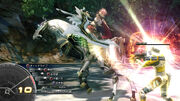
Lightning and Odin's Gestalt Mode.
Each Eidolon's Gestalt Mode includes a powerful finisher move that will end the summoning. The duration of Gestalt Mode is determined by the Gestalt Gauge that appears once an Eidolon is summoned; the gauge will fill as the summoner builds attack chains with their Eidolon.
Missions Edit
Edit
- Main article: Missions (Final Fantasy XIII)
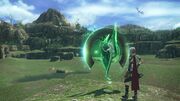
Missions are accepted from Cie'th Stones.
By completing these tasks the party can gain materials and items to improve their equipment. The main difference between the hunts of Final Fantasy XII and the missions of Final Fantasy XIII is that while every hunt can only be completed once, the player may take up each mission multiple times, although the mission reward can be obtained only once; subsequent missions will earn the player a different type of reward, usually of lesser quality (e.g.: Bomb Ashes and Bomb Shells). Replaying these missions is a requirement for those seeking to attain all Achievements or Trophies for the game, as one requires a 5-star battle rating earned for all missions.
Characters Edit
Edit
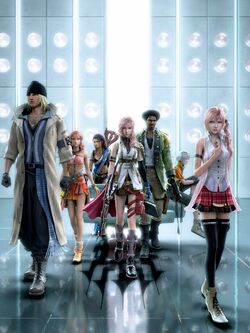
The main characters of Final Fantasy XIII, along with Serah.
- Main article: List of Final Fantasy XIII Characters
Playable Characters Edit
Edit
- Lightning — The main protagonist. Lightning was a member of the Guardian Corps in Bodhum before her life came crashing down when her sister Serah became a Pulse l'Cie. Regretting her refusal to believe Serah, Lightning volunteers to be Purged with the intention of saving her, only to be made a l'Cie like her. She is an agile fighter who makes use of a variety of gunblades, the Blazefire Saber among them.
- Snow Villiers — Leader of NORA, Snow Villiers is a sturdy man whose mannerisms are said to resemble that of a cowboy. He travels to the Hanging Edge to fight PSICOM and the Purge in the hopes of saving his fiancée, Serah, who was imprisoned by the Pulse fal'Cie, only to share her fate as a l'Cie. Although Snow uses his fists to fight, his equipped 'weapon' is a runed coat, designed to enhance the wearer's strength.
- Oerba Dia Vanille — A young and spirited girl with a mysterious past who carries a heavy burden the others are initially unaware of. Getting through the events of the Purge, she tags along with Hope and finds herself wrapped up in the events leading to her joining the others. She acts as the narrator of the story and can be considered a deuteragonist. Her weapon of choice is called the Binding Rod.
- Sazh Katzroy — A middle-aged man with dark skin and an afro. He was formerly in the military, but now works as a civilian airship pilot. In the hopes of saving his son, Dajh, he boards the Purge train to the Hanging Edge, only to become a l'Cie himself. He owns a Chocobo Chick that hides in his hair. He fights with two pistols that can be combined into a rifle.
- Hope Estheim — A young boy who, along with his mother, is part of the group of exiles onboard the Purge train. During an unsuccessful resistance effort by NORA, his mother dies in the conflict. Blaming Snow for his mother's death, Hope follows him but ends up becoming a l'Cie and being forced to work with him and the others as he waits for his chance to get revenge. He wields boomerangs in battle.
- Oerba Yun Fang — A wild-looking woman with a large tattoo on one arm and a scorched mark of the l'Cie on the other. She first appears with Cid Raines and the Cavalry with the intention of capturing Snow in Lake Bresha. However, she has a more complicated agenda, as she searches for a friend and aims to complete her Focus. Spears are her weapon of choice.
Guests Edit
Edit
- Gadot — A member of NORA and Snow's childhood friend. He is a dark-skinned man with orange hair and teal clothes. His design is based on NBA and hip hop fashion. He uses a machine gun in battle.
- Lebreau — A woman with black hair and a butterfly tattoo on her shoulder. She is the only female member of NORA. Her outfit is based on volleyball players, wearing short shorts and a tank top-like shirt with puffy sleeves. She uses a rifle in battle.
Setting Edit
Edit
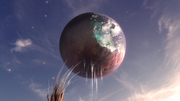
Cocoon.
- See also: Cocoon (Final Fantasy XIII) and Gran Pulse
Cocoon—a utopia in the sky.
Its inhabitants believed their world a paradise. Under the Sanctum's rule, Cocoon had long known peace and prosperity.
Mankind was blessed by its protectors, the benevolent fal'Cie, and believed that tranquil days would continue forever.
Their tranquility was shattered with the discovery of one hostile fal'Cie.
The moment that fal'Cie from Pulse—the feared and detested lowerworld—awoke from its slumber, peace on Cocoon came to an end.
Fal'Cie curse humans, turning them into magic-wielding servants. They become l'Cie—chosen of the fal'Cie.
Those branded with the mark of a l'Cie carry the burden of either fulfilling their Focus or facing a fate harsher than death itself.
A prayer for redemption. A wish to protect the world. A promise to challenge destiny.
After thirteen days of fates intertwined, the battle begins.- —Official Prologue
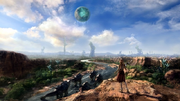
Gran Pulse with Cocoon floating above it.
Six centuries ago, tensions between Cocoon and Gran Pulse rose to the point of war and the War of Transgression broke out. Two Pulsian girls were made l'Cie and bestowed with the power to transform into the legendary beast called Ragnarok to destroy Cocoon. In the war's climax, Ragnarok cracked Cocoon's shell but failed to destroy the floating world. Cocoon was victorious and most of Gran Pulse's population had been wiped out. Cocoon's fal'Cie raided Pulse for raw materials to repair the damage sustained, and the war served to strengthen the people's paranoia towards Pulse.
Music Edit
Edit

The soundtrack's limited edition.
- Main article: Final Fantasy XIII: Original Soundtrack
The Japanese soundtrack was released on January 27, 2010 with two versions available for purchase. The standard version contains four discs while the limited edition contains a bonus "drama CD" written by scenario writer Motomu Toriyama.
In the game's western versions Leona Lewis sings the English theme song, titled "My Hands". Yoshinori Kitase explained the decision to use a different song was made due to difficulties translating the lyrics of "Kimi ga Iru Kara" into English, and thus "My Hands" was chosen as the lyrics of the song still fit the game's theme.[5] In the game's western versions the song "Eternal Love" was replaced with "Serah's Theme".
Development Edit
Edit
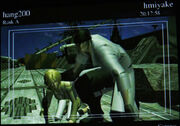
Snow and Nora in the Hanging Edge in a PS2 beta version.
Final Fantasy XIII only had development on the PlayStation 2 at the very beginning of the project, mainly focused around creating the world and story. The team working on Final Fantasy XIII was derailed when they were commissioned to create the Final Fantasy VII technical demo for PlayStation 3; the demo's results were so promising the development of Final Fantasy XIII was moved to this platform as well.[8] The idea from the start was to have a highly action-based battle system.[9]
The development was led by Yoshinori Kitase and as such, the development team resembles that of Final Fantasy X and Final Fantasy X-2, although occasionally, developers from Final Fantasy XV (then known as Final Fantasy Versus XIII) assisted with the game's development.
Final Fantasy XIII was developed on the Crystal Tools engine since the production moved on PlayStation 3. The process of making the company's first PlayStation 3 title proved to be a challenge as the team found it a tricky console to code for.[9] Determined to crack the puzzle, Square opted to create its own development kit, which became known as Crystal Tools.
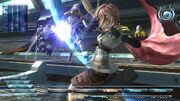
Reveal trailer with a mock up battle menu with battles taking place on the field map.
Final Fantasy XIII was first revealed at E3 2006. Since then, the battle system was changed several times. In the first trailer the camera angles and shifts were more dynamic and Lightning had a gravity-controlling ability that influenced the gameplay, lending to a somewhat more action-based and cinematic presentation than the final, more classic battle system. In the playable demo, the battle transitions were nearly seamless as the exploration and battle fields were very similar in appearance, unlike in the final game where the differences between the two fields are much more apparent.
It was revealed at E3 2008 that Final Fantasy XIII would be released on the Xbox 360 and the PlayStation 3 in North America and Europe, but would remain a PlayStation 3 exclusive in Japan. A demo version of Final Fantasy XIII was released with Final Fantasy VII: Advent Children Complete in Japan on April 16 exclusively for PlayStation 3. Covering a part from the early stages of the game, the demo aimed to familiarize players with the battle system, while featuring Cocoon and the l'Cie. Only Lightning and Snow were playable, with Sazh, Lebreau and Gadot supporting them during battles. The demo was not released outside of Japan.
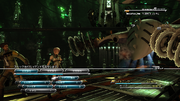
Early battle HUD.
The initial screenshots of the Xbox 360 version Square Enix released to compare to the PlayStation 3 version were revealed, in fact, to be screenshots from the PlayStation 3 version, with the Xbox 360 icons pasted on top. Square Enix apologized, claiming it was a mistake, and later released genuine Xbox 360 screenshots. The Xbox 360 version runs at 576p (FMV CG 576p), as opposed to the PlayStation 3's native resolution of 720p (FMV CG 1080p), but both versions can be upscaled to 1080p.
Similar to Final Fantasy X, Final Fantasy XI, and Final Fantasy XII, Final Fantasy XIII has only English and Japanese audio with subtitles localized to local languages.
A Problematic Development Edit
Edit
After the game's release, Square Enix has revealed that Final Fantasy XIII's development was a difficult one and ridden with miscommunication between different sections of the development team. Final Fantasy XIII had the largest development team of any previous Final Fantasy game, with some of the work also done in conjunction with the Final Fantasy XV team (then-titled Final Fantasy Versus XIII). At the peak, there were over 200 people working on it, with 180 artists, 30 programmers, and 36 game designers.[11] According to the October 2010 issue of Game Developer magazine[12],
a big problem during the game's development was the lack of unified
vision. The game was first announced at 2006, but the E3 trailer was
merely a visual concept and the team hadn't created anything playable
yet, leading to pressure within the development team on what the battle
system should be like. What further complicated the development was that
the team was also working on Square Enix's multi-platform engine
Crystal Tools. The team made the mistake of trying to accommodate every
single project in progress and a considerable amount of time was spent
prioritizing all the different requests and the team was not able to
determine the final spec requirements. It created a standstill between
the engine and game development teams; if the engine's specs couldn't be
finalized, neither could the game's.
Being a large-scale project Square Enix wanted to keep details of the game secret, but this led to the international player testing being too late, which further led to scheduling constraints as the team wanted to ensure the game would appeal to Western audiences. The development team was well-aware of criticism toward JRPGs coming from North America and Europe concerning game linearity and command-based battles; the development team experimented with Western development methods and international focus groups were set up for certain titles, including Final Fantasy XIII.
However, at this time the development team was already far along in development and it was too late to implement most of the feedback. Despite this, the team was able to gain some insight into what players wanted globally, but also led to conflicts because the development team didn't receive clear instructions on whether to force certain changes into an already tight schedule. Much of the feedback which was unable to be included in Final Fantasy XIII, was later used when developing Final Fantasy XIII-2.[11]

Demo gameplay.
The way the development team has come out open with the problems with Final Fantasy XIII's development is rather unique, and may reflect the polarized reception the game received after its release.
Localization Edit
Edit
Final Fantasy XIII was being localized for English as it was
being made, but it had no infrastructure to support simultaneous
development and localization. There were no content freeze deadlines to
ensure the translators were translating with the final context, and cut
scenes were still changing after the English voice recording was
finished. The entire voice script ended up being re-recorded about four
or five times. The translators would have to translate blindly from
text, and then see an early render to notice it would not work. When
placeholder audio would show up the translators would realize their
lines wouldn't match the timing or the emotion that would be on the
characters' faces. The translators had scripts from the writers, videos
of events, transcripts of the actual Japanese voice data, and the latest
game build, but all four would be different and none of them final.
Tom Slattery, who was handling the English localization, and Teruaki Sugawara, the sound engineer, who also subsequently left the company, were both serving as representatives from their respective departments at the monthly meetings between Sound and Localization, and both realized that if that was going to be the way localization was handled on subsequent projects, there needed to be a way of keeping all information synchronized without placing unnecessary burden on the development team, Sound, or Localization. When Final Fantasy XIII-2 would be developed, the developers would use a tool called Moomle to do just that.[13]
Jack Fletcher did voice directing and casting for Final Fantasy XIII; his previous experience in the series includes Final Fantasy X, Final Fantasy X-2, Final Fantasy XII, and Final Fantasy Tactics. Around twenty auditions were held for the important characters and Square Enix would let Fletcher cast the rest on his own by giving him character descriptions on how they wanted the characters to sound.[14] For lead and cameo characters the producers would want to hear at least five to eight different voice samples per character to choose from.
The voice directing team would then pick portions from the game script to send to agencies and get auditions back from them. It has also been mentioned that Square Enix does not want to reuse voice actors too much, so anyone who has played a lead role before is unlikely to get another Final Fantasy lead part soon, and so, even if Ashe's voice actress Kari Wahlgren submitted a good audition, Square would not want to cast her as Lightning.[14] The idea to cast two characters with Australian accents came from the localization team, who requested the voice directing team to look for either Australian or New Zealand sounding voices; the rationale was that the team wanted Fang and Vanille to sound like they were from another world, but more in a sense of having a different melody to their voices, rather than a thick accent.[14]
Employee Departures Edit
Edit
The problematic development of Final Fantasy XIII led to the
departure of several members of the development team, who left Square
Enix during development or on the game's release, including:
- Toshiro Tsuchida (battle planning director)
- Takashi Ohkuma (background technical director)
- Masashi Hamauzu (composer), who went freelance
- Nao Ikeda (sub-character designer), who went freelance[15]
Release Edit
Edit
Final Fantasy XIII was released on December 17th, 2009 in
Japan exclusively for PlayStation 3. Coinciding with the release a
Japanese alcoholic beverage distributor Suntory released the energy
drink Final Fantasy XIII Elixir to promote the game's release. A PlayStation 3 bundle called "Lightning Edition", which includes a copy of Final Fantasy XIII,
was released in Japan on the same day. 200 units were allocated to be
sold in Taiwan. It contains a Ceramic White PlayStation 3 slim 250GB set
with pink Lightning artwork.
On November 13th, 2009 the game creators released a video with interviews and new footage that announced the game's international release date. One month prior to the game's release, Square Enix had begun promoting the game via a tour bus where gamers could preview and play the game, until March 9th, 2010, Final Fantasy XIII was released worldwide on both PlayStation 3 and Xbox 360.
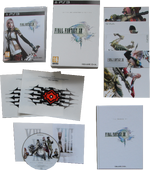
The entire contents of the Limited Collector's Edition.
- Artwork of all six party members with their respective Eidolons.
- Two stickers of the Pulse l'Cie brand.
- The Original Sound Selection, which includes composer Masashi Hamauzu's comments on the ten tracks comprising the selection.
- A hardback book, titled The World of Final Fantasy XIII, which contains scenario information for the game.
Final Fantasy XIII is the first game in the series to receive an official release in Chinese. The localization uses the original Japanese audio with traditional Chinese subtitles, and was made by SEC Asia. Unofficial translations call Final Fantasy "Space Warrior" (太空戰士), but Yoshinori Kitase kept the name "Final Fantasy" for consistency.[16]
The game was released as an Ultimate Hits International Edition on Xbox 360 in Japan on December 16, 2010. It includes a brand new Easy Mode and is packaged with the following content:
- An artwork booklet, titled FINAL FANTASY XIII -Corridor of Memory- with visual art from both Japan and overseas.
- FINAL FANTASY XIII Unused Event Scenes, a look at scenes cut from the game with an accompanying script.
- An epilogue novel, titled Final Fantasy XIII -Episode i-, which reveals the events after the end of the game.
On July 21st, 2011, the Japanese PlayStation 3 version of the game, got a free update, which introduced Easy Mode difficulty, to get on par with the Japanese Xbox360 version released a year earlier.[17] The update also disables the use of preemptive attack to the Ochu enemies, and disables the
Post-Release Edit
Edit
Sales Edit
Edit
In Japan Final Fantasy XIII sold over a million units on its first day of sale and had sold over 1,600,000 copies in Japan at the end of 2009.[18] In March 2010, Square Enix stated that Final Fantasy XIII
is the fastest selling title in the series' history. By April American
game sales reached an estimated 800,000 units for PlayStation 3 and
500,000 units for Xbox 360. As of June 9th, 2011, Final Fantasy XIII has sold over 6.5 million copies worldwide.[19]
Reception Edit
Edit

The Crystarium System was one of the game features that fell under criticism due to emphasizing the game's linear nature.
Final Fantasy XIII has been hailed as a technical milestone with the presentation of CGI cutscenes and the almost seamless transition of visual quality between them and real-time gameplay. Many have appreciated the game's soundtrack though some feel the replacement of the game's original theme song with Leona Lewis's "My Hands" was unfortunate. The game's battle system has been generally liked, with the increased battle speed and the depth of the Paradigm Shift system. The story, characters and voice acting were mostly received well with reviewers stating the characters worked well together, and the interactions among them made up for shortcomings in the storyline.
Many, however, reacted negatively to the game's linear nature especially in the first ten chapters on Cocoon compounded by the absence of traditional towns and little interaction with non-player characters. Many also noted that the slow pace the game opens up, with the Crystarium System only expanding at certain storyline points to allow the characters to learn more abilities, and the rather late point in the game the player is allowed to choose their battle party, contributed to the game's linear feeling, some citing it "boring".
The game director Motomu Toriyama has since stated the lower-than-expected review scores were a result of reviewers approaching the game with a Western point-of-view, and that reviewers were used to games in which the player was given an open world to explore; he noted this expectation contrasted with the development team's vision in that it "becomes very difficult to tell a compelling story when you're given that much freedom".
Final Fantasy XIII ended up being unexpectedly polarizing and is the first Final Fantasy main title to get such a strong reaction from the fans, that even Square Enix CEO, Yoichi Wada, acknowledges it, saying in a Gamasutra interview that "... when it comes to the customers' reaction to the quality of the game, some value it highly and some are not very happy with it".
When the game was rereleased in October 2014 for PC, the game received a "mixed reception" and at its lowest favor rate from the players had 41% of positive reception. Among many issues that made the players disappointed were locked 1280×720 resolution, lack of graphic settings, stuttering, and lag. The game later receives "mostly positives" user reviews on Steam after Square Enix releases a patch update to fix most of the issues in December 2014.
Controversies Edit
Edit
- Initial screenshots of the Xbox 360 version released by Square Enix to compare to the PlayStation 3 version were revealed shortly after to be screenshots from the PlayStation 3 version, with the Xbox 360 control icons pasted on top. Square Enix apologized, claiming there would be no need to enhance the Xbox 360 screenshots and that a mistake was made, and later released screenshots that did come from the Xbox 360 version. Though the screenshots were of low quality, including one with a mouse pointer over it, analysis of the new screenshots and later technical analysis by DigitalFoundry of both versions of the game revealed that the Xbox 360 version runs at 576p (FMV CG 576p), as opposed to the PlayStation 3's native resolution of 720p (FMV CG 1080p). Both versions can be upscaled to 1080p.
- On June 2nd, 2010, a class action lawsuit was filed against Square Enix and Sony Computer Entertainment America due to alleged freezing bugs in the game damaging and physically breaking PlayStation 3 consoles. Square Enix claims it is an issue with the console, while Sony blames the issue on a glitch on the game disc.
- In August 2010, a television advert of Final Fantasy XIII was banned in Britain by the Advertising Standards Authority due to Square Enix advertising the Xbox 360 version of the game with footage of the PlayStation 3 version exclusively.
- After the confirmation that an Xbox 360 port of Final Fantasy XIII would be released in Japan, CEO Yoichi Wada received death threats from angry fans accusing him of being a liar.[20]
Sequels Edit
Edit
A sequel titled Final Fantasy XIII-2 was announced on January 18th, 2011.
Square Enix registered a domain name for Final Fantasy XIII-3 on September 7th, 2011, but no development plans were announced. A representative of Square Enix noted that the filing is to protect the Final Fantasy XIII intellectual property and is not indicative of a new title. On September 1st, 2012, Lightning Returns: Final Fantasy XIII was announced, which is said to be the last installment in the story of Lightning.
Ports Edit
Edit
Microsoft Windows and Steam Edit
Edit
Square Enix announced at Tokyo Game Show 2014 that Final Fantasy XIII, Final Fantasy XIII-2, and Lightning Returns: Final Fantasy XIII are coming to PC and Steam. Final Fantasy XIII
arrived first on October 9, 2014. The game features English and
Japanese dubs, and subtitle in English, French, Italian, German, and
Spanish.[21] The Japanese and Asian version have Japanese audio only, with subtitle in English, Traditional Chinese, and Korean.[22]
The game runs capped at 60FPS. Both Xinput and DirectInput controllers are supported.
A patch update will be released in December 2014. Customizable rendering resolution options are included.[23]
System Requirements Edit
Edit
| Minimum | Recommended | |
|---|---|---|
| OS | Windows® XP SP2 or later | Windows® Vista/ 7/ 8 |
| Processor | 2GHz Dual Core CPU | Intel® Core™ 2 Quad (2.66 GHz)/ AMD Phenom™ II X4 (2.8 GHz) processor |
| Memory | 1 GB RAM | 1 GB RAM |
| Graphics | NVIDIA® Geforce® 8 Series/ ATI Radeon™ HD 2000 series VRAM 256MB or later | NVIDIA® Geforce® GTX™ 460/ ATI Radeon™ HD 5870 |
| Monitor | Screen resolution of 1280x720 is required for fullscreen mode. | Screen resolution of 1280x720 is required for fullscreen mode. |
| Hard Drive | 49.4 GB available space 26.9 GB available space | 49.4 GB available space 26.9 GB available space |
| Sound Card | Sound card compatible with DirectX® 9.0c | Sound card compatible with DirectX® 11 |
| DirectX | Version 9.0c | Version 11 |
Steam Trading Cards Edit
Edit
The Steam version of Final Fantasy XIII comes with 6 Steam Trading Cards; all of them feature Lightning.
iOS and Android Edit
Edit
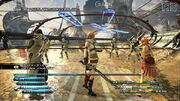
Final Fantasy XIII on mobile devices.
Production Credits Edit
Edit
Staff Edit
Edit
| Producer & Game Designer | Yoshinori Kitase |
|---|---|
| Director & Scenario Designer | Motomu Toriyama |
| Main Programmer | Yoshiki Kashitani |
| Art Director | Isamu Kamikokuryo |
| Graphics & VFX Director | Shintaro Takai |
| Main Character Designer | Tetsuya Nomura |
| Image Illustration | Yoshitaka Amano |
| Storyboard Director | Yoshinori Kanada |
| Music | Masashi Hamauzu |
| Scenario Concept | Kazushige Nojima (Stellavista) |
| Lead Scenario Writer | Daisuke Watanabe |
| Event Planning Director | Takeshi Iwabuchi |
| Map Planning Director | Takayoshi Nakazato |
| Battle Planning Director | Toshirō Tsuchida |
| Lead Battle Programmer | Yusuke Matsui |
| Character Modeling Director | Hideo Kubota |
| Character Texture Director | Masaaki Kazeno |
| Battle Motion Director | Yoshiyuki Soma |
| Event Motion Director | Yusuke Tanaka |
| Cut Scene Director | Koji Kobayashi |
| Lead Cut Scene Programmer | Naoki Hamaguchi |
| Background Graphic Director | Yoichi Kubo |
| Background Technical Director | Yoshihiko Ōta |
| Lead Layout Tool Programmer | Mamoru Oyamada |
| Menu Director | Yoichi Seki |
| Lead VFX Engine Programmer | Yasunari Ohinishi |
| Movie Directors | Takeshi Nozue, Eiji Fujii |
| Sound Director | Tomohiro Yajima |
| Associate Producer | Hideki Imaizumi |
| Publicity Producer | Akio Ohfuji |
Voice Cast Edit
Edit
| Character | Japanese | English |
|---|---|---|
| Lightning | Maaya Sakamoto | Ali Hillis |
| Snow Villiers | Daisuke Ono | Troy Baker |
| Sazh Katzroy | Masashi Ebara | Reno Wilson |
| Oerba Dia Vanille | Yukari Fukui | Georgia Van Cuylenburg |
| Hope Estheim | Yūki Kaji | Vincent Martella |
| Oerba Yun Fang | Mabuki Andou | Rachel Robinson |
| Serah Farron | Minako Kotobuki | Laura Bailey |
| Galenth Dysley | Masaru Shinozuka | S. Scott Bullock |
| Jihl Nabaat | Mie Sonozaki | Paula Tiso |
| Yaag Rosch | Hiroki Touchi | Jon Curry |
| Cid Raines | Yūichi Nakamura | Erik Davies |
| Rygdea | Yasuyuki Kase | Josh Robert Thompson |
| Gadot | Biichi Satou | Zack Hanks |
| Lebreau | Yū Asakawa | Anndi McAfee |
| Maqui | Makoto Naruse | Daniel Samonas |
| Dajh Katzroy | Shoutarou Uzawa | Connor Villard |
| Yuj | Wataru Hatano | Jeff Fischer |
| Nora Estheim | Komina Matsushita | Mary Elizabeth McGlynn |
| Bartholomew Estheim | Masaki Aizawa | André Sogliuzzo |
| Amodar | Yûji Ueda | Dave Wittenberg |
| Orphan | Hiro Shimono (True Form) Mie Sonozaki & Masaru Shinozuka (Shell) | Michael Sinterniklaas (True Form) Julia Fletcher & S. Scott Bullock (Shell) |
| Girl with Carbuncle | Stephanie Sheh |
- Cocoon Inhabitants (English version)
| April Stewart, Ben Diskin, Candi Milo, Chris Edgerly, Colleen O'Shaughnessey, Dante Basco, Dave Rasner, Eden Riegal, Fred Tatasciore, Hynden Walch, JB Blanc, Jessica DiCicco, Jim Ward, John DiMaggio, Kari Wahlgren, Keith Silverstein, Kirk Thornton, Liam O'Brien, Masasa Moyo, Michael Gough, Mickey Cheetham, Neil Kaplan, Nolan North, Patrick Seitz, Robbie Rist, Roger Craig Smith, Scott MacDonald, Sheri Lynn, Steve Van Wormer. |
Packaging Artwork Edit
Edit
Final Fantasy XIII is the first Final Fantasy title with European packaging artwork that does not only feature the game's logo, but the main protagonist as well.
Gallery Edit
Edit
- See also: Final Fantasy XIII/Concept Art
Main cast of Final Fantasy XIII by Yoshitaka Amano.
Allusions Edit
Edit
- Main article: Final Fantasy XIII/Allusions
Trivia Edit
Edit

Chocobo for X360 Avatar.

Male PSICOM Uniform for X360 Avatar.
- During the development, models of Yuna, Rikku, Ashe, and Vaan were used as stand-ins for characters that weren't finished yet.
- The PlayStation 3 version came with a code that, when registered with Square Enix's community website, allowed one to register to be a beta tester for Final Fantasy XIV.
- In the lead-up to the release of Final Fantasy XIII, Microsoft ran a promotion where a Chocobo Avatar item would become available if a certain amount of the hashtag '#FFXIIIXBOX' had been used on Twitter or if one registered with an email. The chocobo looks and behaves similarly to the one Sazh carries around with him.
- Players who registered a first production run of the Xbox 360 version at the Square Enix Members site received download codes for Male and Female PSICOM uniforms for their Xbox Live Avatar.
- The game was originally planned to have downloadable content (DLC) released after the game, but Square Enix scrapped the plans.[25]
- Final Fantasy XIII is the first main series game to not feature either the original "Prelude" or "Victory Fanfare".
- Final Fantasy XIII marks the fourth time Square Enix has enlisted a non-Asian vocalist (Leona Lewis) to perform a vocal piece for a Final Fantasy soundtrack, after Final Fantasy X, Final Fantasy X-2, and Dissidia Final Fantasy.
- An Easter Egg exists where if the player spins the analog stick as is common for grinding in previous games, the player character will stop and get irritated.
- The game was released in Japan on December 17, 2009, a day before the anniversary of the original Final Fantasy which was released in Japan on December 18, 1987.
Story
Fates Intertwined Edit
Edit

The floating continent, Cocoon.
- See also: Datalog/The Thirteen Days and Datalog/Events

The PSICOM army Purges the town of Bodhum.
One day there was an incident at the Euride Gorge Energy Plant believed to have been caused by Pulse l'Cie. Six days later, a Pulse fal'Cie was discovered in the seaside town of Bodhum. Mass panic broke out and soon Cocoon's citizens were crying out for the expulsion of the entire town to Pulse, prompting the Sanctum to initiate the Purge. Within the next two days the Sanctum's personal army, PSICOM, quarantined Bodhum, seized the town's inhabitants regardless of whether they are citizens or tourists, and forced them onto Purge trains. The people are taken to the restricted Hanging Edge zone, along with the Pulse fal'Cie, Anima, contained within the Pulse Vestige.
One of the many onboard a Purge train is Lightning, a former Guardian Corps soldier who seeks to reach Anima and save her sister, Serah Farron, who ten days prior had become a Pulse l'Cie and is now being held captive by Anima. Accompanying her is Sazh Katzroy, a civilian airship pilot with a secret reason for pursuing the fal'Cie. They stop the train and fight their way through the Hanging Edge as the Purge's true nature is revealed: instead of a forced migration to Pulse as the Sanctum had everyone believe, it is a genocide. Elsewhere, Snow Villiers and his friends in NORA rally the deportees in a rebellion against PSICOM as he is also trying to rescue Serah, as she is his fiancée. Two youths caught up in the chaos, Hope Estheim and Vanille, become involved when Hope's mother, Nora Estheim, joins Snow's resistance army and dies under his care, prompting the two to pursue him.

Serah enters a crystal sleep.
As the party faces Anima, PSICOM forces blast the Pulse Vestige and everything in it to pieces. The party is transported into an otherworldly realm where the god Pulse transforms Lightning and her companions into l'Cie, showing them a dreamlike vision of their Focus involving the capital city of Eden and Ragnarok. They fall down towards Lake Bresha below but survive due to Anima crystallizing the area in its death throes.
Separate Paths Edit
Edit
Now enemies of the state, the newly branded l'Cie assume their Focus
is to destroy Cocoon although Snow believes it to be Serah's wish to
save it. They set off to escape the lake and come across Serah's
crystallized form that has become part of the crystallized lake. Snow
insists on staying by Serah's side while the others seek to outrun
pursuit as PSICOM is hunting them and other Purge survivors. The party
splits with Snow staying to dig out Serah, while Lightning and rest head
to the ruins of an old city at the lake's edge where they come across
an airship left by a PSICOM patrol.
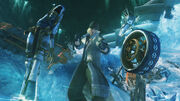
Snow and the Shiva Sisters.
Sazh pilots the stolen airship through the blockade and while onboard the group views a live newscast interviewing Galenth Dysley about the ongoing operation being carried out by PSICOM after the "success" of the Purge. The airship is shot down by PSICOM pursuit and crashes in the Vile Peaks. The party splits after a disagreement on their Focus: Sazh and Vanille wish to flee from their pursuers, but Lightning is intent on getting revenge by destroying the Sanctum and the fal'Cie Eden said to be in control of it. Accompanied by Hope, she intends to travel through the Gapra Whitewood, his hometown of Palumpolum, and take a train to Eden, the heart of the Sanctum government.
As she and Hope trek through the remainder of the Vile Peaks the pressure of keeping Hope safe and dealing with the enemy soldiers take their toll on Lightning and she snaps at him for being unable to keep up with her. The Eidolon Odin appears and attacks Hope as if to force her to choose between her mission and him. Together they bring the Eidolon under control, and Lightning resolves to help Hope toughen up as they continue on their mission together.
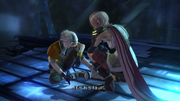
Lightning and Hope in the Gapra Whitewood.
After making their way out of the Vile Peaks, Sazh and Vanille travel through the Sunleth Waterscape towards Nautilus. Sazh confesses why he went to the Hanging Edge; his son, Dajh Katzroy, was made a Sanctum l'Cie by the fal'Cie Kujata during the incident at Euride Gorge. Sazh suspected his Focus was to destroy Anima when Dajh sensed the Pulse Vestige in Bodhum and caused the Purge. To save Dajh from becoming a Cie'th, a mindless shambling monster that a l'Cie becomes if they fail their Focus, Sazh boarded the Purge train with Lightning to try and complete Dajh's Focus for him. Unbeknownst to Sazh, Vanille knows more about the Euride incident than she lets on.
Truths Revealed Edit
Edit

Snow and Fang save Hope and Lightning.
Elsewhere, Hope confronts Snow about his mother's death, intending on taking his revenge. His plans are foiled when a PSICOM warmech attacks them and Snow saves Hope from further harm by cushioning their fall from the rooftops. Snow apologizes to Hope for what happened to Nora and the two settle their differences. Fang, Lightning, Hope and Snow are reunited and head to the Estheim Residence where Snow recovers from his injuries while Hope informs his father of Nora's fate and repairs his relationship with him.
While the party is busy formulating a plan to deal with the Sanctum, PSICOM officer Yaag Rosch arrives with his troops. Snow tries to make them realize they wish to protect Cocoon and demands the Purge to be stopped, but Yaag claims the lives of Pulse l'Cie are not worth the risk of sparing, and that the Purge is demanded by the people of Cocoon. After a confrontation with an attack shuttle, Snow, Lightning, Hope and Fang are rescued by Rygdea and taken onboard the Lindblum with help from Cid.
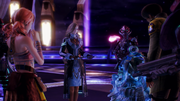
Jihl reveals the truth about Vanille to Sazh.
Furious, Sazh confronts Vanille, triggering the appearance of his Eidolon, Brynhildr, which he brings under control with Vanille's help. In his grief, Sazh tries to shoot himself but is unable to do so, prompting the PSICOM soldiers to take him and Vanille into custody. They are taken aboard the Palamecia to be transported to Eden for live execution. During their imprisonment Vanille reveals her origins to Sazh: she and Fang became l'Cie to fight Cocoon during the War of Transgression and entered crystal stasis on Pulse. Twelve days before the Purge they awoke in Cocoon but Fang had lost her memory of their previous Focus. Not wanting any more people to get hurt because of them, Vanille lied to also have lost her memory and has been running from her fate ever since.
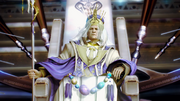
Galenth Dysley aboard the Palamecia.
After suffering defeat at the hands of the l'Cie, Barthandelus reveals the l'Cie's Focus is to become Ragnarok and destroy Orphan, the fal'Cie that powers all the other fal'Cie in Cocoon and holds it afloat over Pulse. Barthandelus claims Serah's Focus was to gather them together to be made l'Cie so they could bring about Cocoon's destruction, a revelation that cripples Snow. Barthandelus departs, leaving behind his familiar Menrva to serve as an airship for them to escape from the now-sinking battlecruiser. The l'Cie make their escape, avoiding pursuit from Yaag Rosch onboard The Proudclad, ending up inside the Fifth Ark hidden underneath Eden. Fang and Vanille recall a legend concerning the purpose of the Arks, armories and training grounds for l'Cie.
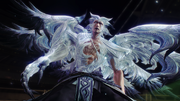
Cid reveals the truth in the Fifth Ark.
Shaken by the turn of events, the l'Cie reach a dead end. Snow decides to follow Cid's example and forget their Focus and fulfill Serah's final wish of saving Cocoon. While everyone else agrees, Fang turns on them, proclaiming that even though they might wish to save Cocoon she would rather follow their Focus to destroy it than see any of her friends become a Cie'th for defying it. Fang unwittingly summons Bahamut, and brings it under her control with the others' help, reluctantly agreeing to follow with their plan. The l'Cie discover a new path following Bahamut's "taming" and a Pulsian airship at the end, which they use to travel through a portal leading to Gran Pulse.
Terra Incognita Edit
Edit
The airship is attacked by a wild wyvern in the skies above Pulse and the l'Cie become stranded in the valley of Vallis Media. The party searches Gran Pulse for days looking for a way to remove their brands but find no traces of human life. Sazh's Chocobo Chick
warns the party that Hope's l'Cie brand is advancing and he has fallen
unconscious. They bring Hope back to the base camp and Vanille suggests
they go to Oerba, her and Fang's hometown. Hope wakes up and tells them he should remain behind but his Eidolon Alexander
is summoned and brought under his control. After Hope is given newfound
strength, the l'Cie come to believe the true purpose of the Eidolons is
to give l'Cie hope instead of freeing them through death.
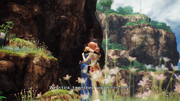
Fang assures Vanille they now have a new family.
The l'Cie traverse the remainder of the Mah'habara mines and use the fal'Cie Atomos to reach the Sulyya Springs, where Vanille speculates Barthandelus lied to them about Serah's Focus, and that she had overcame her Focus and turned to crystal like Cid had. They reach Taejin's Tower, a crumbling mechanical tower where the fal'Cie Dahaka makes its home. The Menhirrim there help them destroy the errant fal'Cie and reach the top of the tower from where the l'Cie ride a capsule down to the slopes of Oerba. They find the village covered in a blanket of snow-like crystal dust and infested with Cie'th. At the end of a crumbling railway overpass the l'Cie are shocked to find Serah waiting for them.
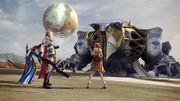
Barthandelus confronts the l'Cie.
After defeating him Barthandelus gloats how the citizens of Cocoon are fighting among themselves now that the resurrected Cid has become the new Primarch. He warns them the Cavalry is mounting an attack to destroy Orphan under the belief it would free Cocoon from the fal'Cie rule, and they have a choice: destroy Orphan themselves or let the people of Cocoon destroy it. He leaves behind another airship and returns to Cocoon to oversee the final stages of his plan. The l'Cie find an ancient record telling the War of Transgression's aftermath: the reason Fang hadn't destroyed Cocoon was because the goddess Etro intervened and turned her and Vanille to crystal before they could. Later, after Vanille and Fang's crystals were placed inside the Pulse Vestige, Barthandelus brought the Vestige into Cocoon so they could finish the job when they awoke. The party decides to return to Cocoon and either save Orphan or die trying. They board the airship and use a portal in Pulse's atmosphere to return to Cocoon.
Eden Under Siege/The Cradle Will Fall Edit
Edit
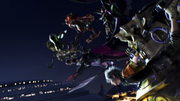
The l'Cie return to Cocoon.
The citizens take shelter at Edenhall and at the center of the complex, the l'Cie spot crystal shards floating in the air. An illusion of Barthandelus appears telling them the shards are the souls of the departed, and their presence signals the appearance of the Door of Souls and the Maker's inevitable return, and tells them he has their "loved ones" captive. The Calvary soldiers and PSICOM troopers in their vicinity turn into Sacrifice Cie'th, the result of Barthandelus branding them without giving them a Focus. They are confronted by Yaag Rosch, who, after being defeated for the second time, helps the l'Cie by ordering his soldiers to evacuate the city rather than search for the l'Cie and detonating the Proudclad's wreckage, sacrificing himself and ensuring the party won't be followed into Orphan's Cradle, an alternate dimension serving as the true command center of Cocoon.
Inside Orphan's Cradle the l'Cie discover the remainder of the Calvary soldiers have been converted into Cie'th. Guided by the fal'Cie Eden, they arrive at the Narthex, Orphan's resting place. Barthandelus destroys Serah's and Dajh's crystallized forms and commands the l'Cie to fulfill their destiny by destroying Orphan, thereby cutting the power fueling Cocoon's functions and causing it to crash onto the surface of the lowerworld. The l'Cie see through Barthandelus's illusions, and Barthandelus engages them in battle only to be defeated and sent sinking into a pool of liquid. Menrva dives into the pool allowing Barthandelus to rise up as the protective shell surrounding the dormant fal'Cie Orphan.
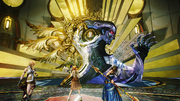
The party faces the merged form of Barthandelus and Orphan.
Orphan tortures Vanille to force Fang to transform into Ragnarok. Seeing no way out of their situation, Fang submits but the others try to stop her. She overpowers them, causing everyone except her and Vanille to turn into Cie'th. Fang is attacked by the shambling remnants of her companions, triggering her transformation into an incomplete version of Ragnarok. Fang's Ragnarok is unable to destroy Orphan; only the outer shield dissipates before Fang reverts. Orphan revives Fang and tortures her to force her to transform into Ragnarok once more while a helpless Vanille watches her friend suffer. Meanwhile, Lightning, Snow, Sazh, and Hope relive the memories of their journey and find the strength of will to revert, though they believe their Cie'th forms were another fal'Cie illusion. As Vanille prepares to make a stand against Orphan, the others fire magic spells at Orphan and save Fang from the fal'Cie, who sinks into the pool.
After giving themselves the Focus of saving Cocoon rather than destroying it, the party's l'Cie brands burn out. Orphan's true form rises from the pool, and reveals it shares the same desire as Barthandelus to summon the Maker, even if it means its death. Believing that if they can destroy Cocoon, they can also save it, the l'Cie destroy Orphan.
The Dawn of a New Era Edit
Edit
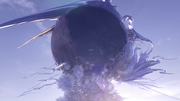
Cocoon, crystallized by Ragnarok.
Through an unknown force, Lightning and her companions wake up from their crystal sleep. Finding their l'Cie brands gone, the group is reunited with Serah and Dajh who were also revived and are normal humans again. While the Cocoon survivors rally around the remaining military units as they see Gran Pulse for the first time, Hope takes a moment to mourn for Fang and Vanille while Lightning gives Serah her blessing to marry Snow. Within the core of the crystal pillar holding Cocoon above Gran Pulse, the crystallized forms of Vanille and Fang float, still holding hands, their Focus complete.
Web Novelization Edit
Edit
The official Japanese website revealed a web novelization titled Final Fantasy XIII Episode Zero -Promise-
that contains a series of short stories written by Jun Eishima, leading
up to the game events. The first story is called "Encounter", and
focuses on Serah becoming the first Gran Pulse l'Cie on Cocoon for a
long time. The second story is called "Stranger", and is about the
moment Vanille and Fang awoke from crystal stasis, and began adjusting
to Cocoon life. The third story, "Family", focuses on Sazh and his son,
Dajh, detailing how Sazh came to own the Chocobo Chick and how Dajh fell
into the Sanctum's clutches.
The fourth story, "Search", details Vanille and Fang's separation, Fang's encounter with Cid Raines, and joining him to locate Vanille. Part five of the novel is titled "Friends", and focuses on Hope Estheim's life with his family and friends before his mother's death. The sixth story, titled "Present", involves Snow buying engagement necklaces and Serah finding a birthday present for Lightning. The seventh and final story, called "Tomorrow", is about Fang and Vanille preparing to become l'Cie during the War of Transgression, and Vanille getting ready to be Purged to Gran Pulse.
Themes
The main themes of Final Fantasy XIII are challenging fate and
the concept of willpower. The main cast has an unjust fate (Focus)
forced upon them and seek a way to escape it and do what they believe is
right. Ultimately free will triumphs over fate, as the party rejects
their Focus and follows their true desire, to save Cocoon. The themes
are present with the characters of Serah and Cid Raines, who similarly
defy their fate, and with the interactions of Hope and his father, who
tells Hope he must find his own path in life. The fal'Cie are on the
other side of this coin, unable to follow their heart's desire as their
fate is predetermined by their creator.
Despite lacking magical powers and immortality like the fal'Cie, humans are still implied to be stronger in the end due to possessing free will, and Orphan explains to the party that humans' infinite potential is why fal'Cie chose to make l'Cie of men to carry out tasks they themselves are unable to do. Having a white l'Cie brand may represent a human's free will triumphing over the bond of a fal'Cie-given Focus, as in the end of the game, all of the party's l'Cie brands burn out, which is known to halt the process of turning into a Cie'th.
Many characters in Final Fantasy XIII suffer great losses in losing their homelands and loved ones, and the different ways they deal with their losses are at the center of their character arcs. While their first reaction is anger and vengeance, the party must come to terms with their losses and ultimately realize that revenge is futile, and the only way to cope is to move forward. Related themes are the themes of guilt and running away from the past, the things the party are forced to face if they wish to move on.
Other central themes in Final Fantasy XIII are theocracy, a system of government that rules under a single God recognized as the supreme ruler, and totalitarianism, a government system in which all aspects of life are controlled by the supreme ruler and any opposition is forbidden. Following theocracy, the Sanctum of Cocoon is ruled by the fal'Cie Eden that communicates through Primarch Dysley, who acts as Eden's messenger and makes its orders known to the rest of Cocoon. In accordance to totalitarianism, the military forces follow the Sanctum's policies without question and ensure the populace follows suit, justifying their actions by claiming them to be for the greater good of everyone and necessary to keep the peace, and willing to go as far as fire upon unarmed civilians who try to escape or resist.
The Sanctum uses propaganda and false pretenses to control the public and cover up its true intentions, the prime example being the Purge, a method to slaughter civilians supposedly tainted by Pulse by pretending to cast them out to the lowerworld, "execution masquerading as exile" as Lightning points out. The Cocoon society pushes their own fears away by Purging anyone connected to Pulse, and it is a personal revelation to Lightning when she realizes she is doing the same in having initially set out to destroy Eden.
Another theme is the union of two worlds. For centuries, the people of Gran Pulse and Cocoon have despised and lived in fear of each other. Those from Cocoon are conditioned by the fal'Cie acting through the Sanctum to believe Gran Pulse to be hell and to fear and hate anything having to do with Pulse. The people of Pulse call Cocoon a "floating nest of vipers" and hate the people of Cocoon for luring Pulsians to their world and stealing their resources. The party realize their two worlds and their people are more similar than they thought. It is when Gran Pulse and Cocoon are connected by the crystal pillar formed by Ragnarok that the hostility ends and the two worlds become one.
Despite lacking magical powers and immortality like the fal'Cie, humans are still implied to be stronger in the end due to possessing free will, and Orphan explains to the party that humans' infinite potential is why fal'Cie chose to make l'Cie of men to carry out tasks they themselves are unable to do. Having a white l'Cie brand may represent a human's free will triumphing over the bond of a fal'Cie-given Focus, as in the end of the game, all of the party's l'Cie brands burn out, which is known to halt the process of turning into a Cie'th.
Many characters in Final Fantasy XIII suffer great losses in losing their homelands and loved ones, and the different ways they deal with their losses are at the center of their character arcs. While their first reaction is anger and vengeance, the party must come to terms with their losses and ultimately realize that revenge is futile, and the only way to cope is to move forward. Related themes are the themes of guilt and running away from the past, the things the party are forced to face if they wish to move on.
Other central themes in Final Fantasy XIII are theocracy, a system of government that rules under a single God recognized as the supreme ruler, and totalitarianism, a government system in which all aspects of life are controlled by the supreme ruler and any opposition is forbidden. Following theocracy, the Sanctum of Cocoon is ruled by the fal'Cie Eden that communicates through Primarch Dysley, who acts as Eden's messenger and makes its orders known to the rest of Cocoon. In accordance to totalitarianism, the military forces follow the Sanctum's policies without question and ensure the populace follows suit, justifying their actions by claiming them to be for the greater good of everyone and necessary to keep the peace, and willing to go as far as fire upon unarmed civilians who try to escape or resist.
The Sanctum uses propaganda and false pretenses to control the public and cover up its true intentions, the prime example being the Purge, a method to slaughter civilians supposedly tainted by Pulse by pretending to cast them out to the lowerworld, "execution masquerading as exile" as Lightning points out. The Cocoon society pushes their own fears away by Purging anyone connected to Pulse, and it is a personal revelation to Lightning when she realizes she is doing the same in having initially set out to destroy Eden.
Another theme is the union of two worlds. For centuries, the people of Gran Pulse and Cocoon have despised and lived in fear of each other. Those from Cocoon are conditioned by the fal'Cie acting through the Sanctum to believe Gran Pulse to be hell and to fear and hate anything having to do with Pulse. The people of Pulse call Cocoon a "floating nest of vipers" and hate the people of Cocoon for luring Pulsians to their world and stealing their resources. The party realize their two worlds and their people are more similar than they thought. It is when Gran Pulse and Cocoon are connected by the crystal pillar formed by Ragnarok that the hostility ends and the two worlds become one.
___________________________________________
Need More Detail ? contact me !!
I sell a lot of stuff, program. knowledge, etc.. at a small cost.
I will guide you step by step, personally.
My Paypal Account is : ksw.industries@gmail.com
Don't know how to send money ? Click here for detail about Paypal account.
http://xyberpast.blogspot.com/2014/05/how-to-get-my-program.html
Don't have money? OK! Here is another way to get the program.
how to get my program - Free of charge

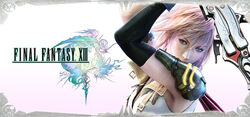
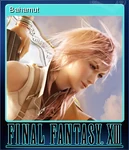



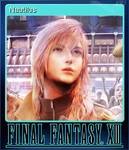
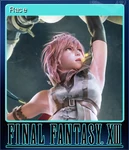



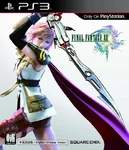













No comments:
Post a Comment